Porcelain Insulator News
by Elton Gish
Reprinted from "Crown Jewels of the Wire", July 2003, page 13
In the last PIN that appeared in the April 2003 issue of CJ, we talked about
foreign styles made by the R. Thomas & Sons Co. You may recall, the 1925
American Jobbers Supply Co. catalog showed five styles including a
"gingerbread man". All of these were made of dry process porcelain.
Paul Axman sent me copies of pages from the Illinois catalog No. 103 dated July
1927. The same five insulator styles are shown on two pages. The standard glaze
was white. One of the pages is reproduced here. Note that the insulators appear
to be marked with the Illinois' map logo with the catalog number inside the map.
Naturally, Illinois did not mark the insulators since Thomas made them.
Illinois
Electric Porcelain Co. started making wet process porcelain in 1915. That line
quickly replaced their dry process line of insulators started in 1910 that was
embossed "MACOMB". They stopped making dry process insulators some
time in the 1920's and most likely around 1920 or shortly thereafter. Illinois
production was probably all wet process porcelain by 1925 when they installed
one of the first tunnel kilns used by the industry. To be competitive in the
foreign market, they probably had to use cheaper dry process porcelain, and
contracted this work out to Thomas. We have confirmed Thomas made all the known
dry process foreign styles from the group of five. Illinois cataloged them using
a "V" with the catalog number to designate another manufacturer. And
Illinois also sold the foreign line of insulators through American Jobbers
Supply Co.
Thomas was not the only U.S. company to make pin-type insulators for
the foreign market. Locke introduced three small foreign style insulators and
three shackle insulators in their 1916 catalog. This line continued unchanged
through their 1925 catalog and was dropped for the 1927 catalog. They also
offered European style "gooseneck" or hook-shaped steel pins for
mounting on the side of a pole as was and still is common in Europe.. While the
Illinois styles did not indicate a pinhole size, the Locke styles indicated four
threads per inch with a 1" pinhole for the largest size and _" pinhole for
the two smaller ones. I'm not familiar with foreign pinhole sizes but believe
the 1" pinhole seems a bit odd for foreign insulators. Note, too, that all
the European style insulator illustrations in the Locke catalog appear to be
brown glazed. You might check the unmarked brown-glazed foreign insulators in
your collection to see if they are similar to the ones Locke produced from 1916
to 1925. What makes the identification difficult is the Locke European styles
were made of wet process porcelain as were those produced in England, Germany,
and other European countries.
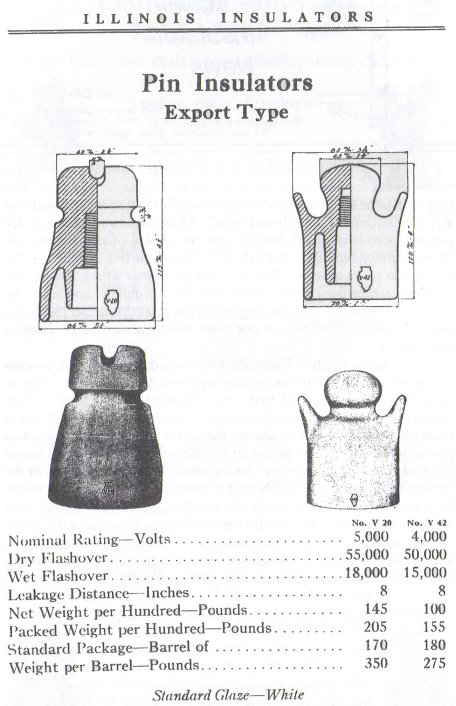
Page from Illinois catalog No. 103 dated July 1927.
This time period must have been a time of
particularly fast growth in European countries. Maybe it had something to do
with WW I, which could have dramatically reduced insulator production from
England and most probably Germany. You may recall that Fred Locke, too, was
having glass insulators made at Corning using his patented glass formulas that
were similar to Pyrex, and he was trying to sell insulators to a company in
Italy. Of course, Fred Locke's insulators for Italy were suspension insulators
for high voltage transmission work. The smaller telephone style insulators
produced by Thomas and Locke probably had more to do with loss of production
capacity as the result of the war.
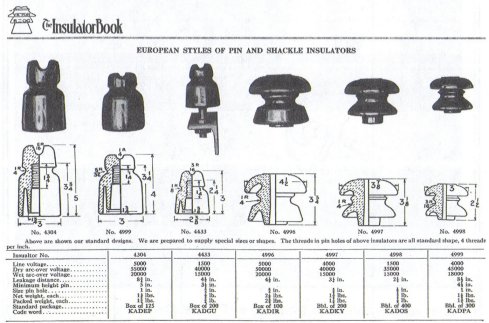
From the 1919 Locke catalog.
The Illinois catalog also showed very similar shackle insulators but did not
carry the "V" catalog notation and the insulators were probably made
of wet process porcelain at the Illinois factory.
The LSIC had a great
get-together at Marilyn and Bill Albers' ranch last weekend with a swap meet and
excellent barbeque with all the trimmings. In Marilyn's collection I found one
of the brown Thomas twist-lock insulators pictured at the bottom of page 41 in
April CJ. The sticker said it came from Mike Guthrie. So at least two specimens
are known. These were made by Thomas of dry process porcelain. I also
photographed a white twist-lock insulator in Marilyn's collection that was crude
enough to be U.S. made. For some reason, the illustration and discussion of this
unusual style was inadvertently left out of the PIN article in April CJ.
The
Ohio Brass Co. made this style of twist-lock and called it the "Cuban
Type". I feel certain that Ohio Brass made Marilyn's white insulator. Jack
Tod found a blueprint at the Ohio Brass factory that was dated April 20, 1908.
It did not reproduce very well, but hope you can see enough of it to tell what
it is reproduced here. The blueprint called for a white glaze. The twist-lock fingers were similar to the Thomas version. I would like to hear from
anyone who has one of the twist-lock designs made by Thomas or Ohio Brass or any
of the foreign styles we discussed earlier.
This blueprint of the "Cuban Type" was found by Jack Tod at the
Ohio Brass factory.
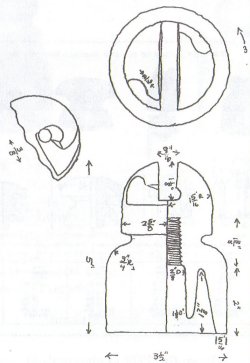
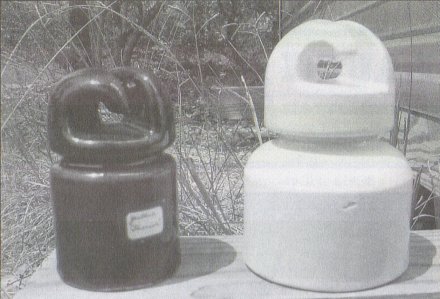
The one on the left is a Thomas dry process twist-lock.
The one on the right
is a "Cuban Type" made by Ohio Brass.
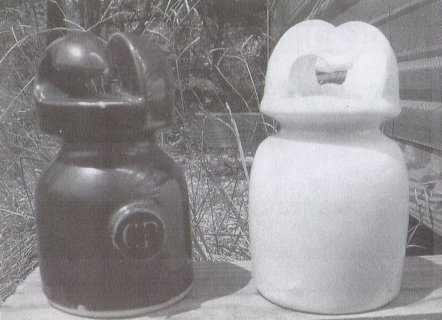
Two more twist-lock insulators. The one on the left has a large raised
button
with CP embossed. I believe the white one is unmarked.
Photos from Marilyn
Albers' Collection.
| 